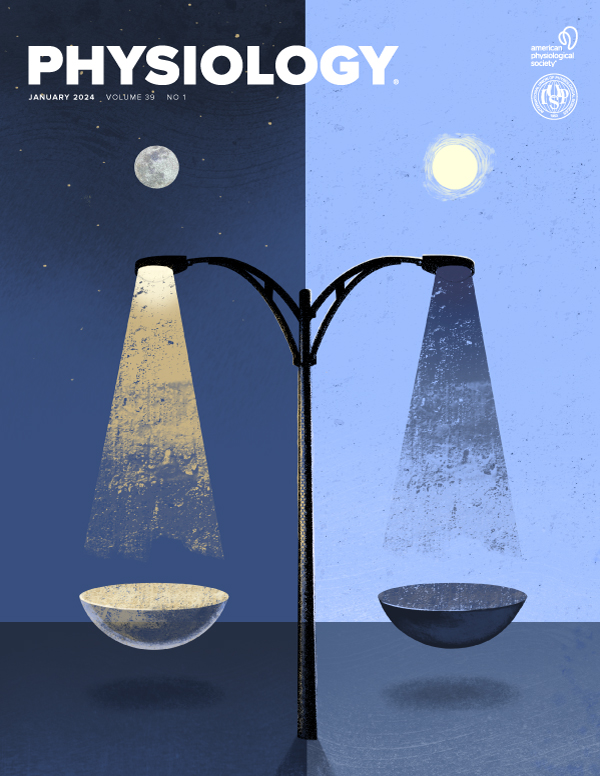不同哺乳动物物种在葡萄糖诱导下的细胞形态变化
IF 5.3
2区 医学
Q1 PHYSIOLOGY
引用次数: 0
摘要
所有生物都会遇到环境波动,必须与这些变化作斗争,以维持体内平衡。有些哺乳动物能承受较大范围的细胞内条件,而有些则不能。葡萄糖水平的变化就是细胞可能遇到的生理挑战的一个例子。我们采用比较法研究了从皮肤活检组织中获得的真皮成纤维细胞对培养过程中改变的葡萄糖处理的反应。具体来说,我们研究了已知能耐受一定范围血糖水平的哺乳动物(食果猿和埃及猿)以及冬眠动物(地松鼠)的反应,后者的葡萄糖代谢在冬季明显下降。作为对比,我们研究了血糖保持相当稳定的物种(人类和大鼠)。在基线(8 毫摩尔葡萄糖)条件下培养成纤维细胞,然后对其进行 24 小时的低血糖(2.5 毫摩尔)和高血糖(30 毫摩尔)处理。我们使用海马 XFp 分析仪测定了人和大鼠成纤维细胞的糖酵解率,发现不同葡萄糖处理的耗氧量或糖酵解率之间没有显著差异(均 p>0.05)。为了研究潜在的细胞表型,我们使用了细胞绘画技术,用荧光染色来标记细胞器。Hoechst 34580 可对 DNA 进行染色,以量化细胞核的数量和大小,从而了解细胞的增殖情况。MitoTracker Deep Red可视化线粒体,提供有关能量生成的信息。Alexa Fluor 488 氨基甲酸共轭物标记内质网。用 Alexa Fluor 555 磷脂酰蛋白共轭物染色 F-肌动蛋白,检测细胞骨架组织和整体细胞结构。使用 CellProfiler 软件分析图像,该软件可提取约 1400 种细胞形态特征,包括面积、紧密度、荧光强度和细胞连接性,以量化表型的微妙变化。每个提取的特征都将在不同处理和比较背景下进行比较。我们预测,暴露于高血糖的成纤维细胞会表现出线粒体破碎和重新分布(MitoTracker)以及活性氧生成增加(用 MitoSOX 评估),这与线粒体通透性转换孔的打开有关。细胞剖面分析仪(Cell Profiler)分析将确定可能预示负面结果(如有丝分裂)的结构变化。高血糖还可能诱发内质网压力,增加脂滴,改变内质网的形状和大小。相反,低血糖会导致线粒体降解。无论是高血糖还是低血糖,增殖率都会下降,导致细胞核减少和细胞连接性降低。根据生物表型评估不同物种的表型差异,将有助于解释哺乳动物在环境压力下的细胞功能机制。国家自然科学基金资助#2022046。本文是在 2024 年美国生理学峰会上发表的摘要全文,仅提供 HTML 格式。本摘要没有附加版本或附加内容。生理学》未参与同行评审过程。本文章由计算机程序翻译,如有差异,请以英文原文为准。
Glucose-Induced Cellular Morphological Changes Across Mammalian Species
All organisms encounter environmental fluctuations and must contend with these changes to maintain homeostasis. Some mammals tolerate a wide range of intracellular conditions while others do not. Altered glucose levels are an example of a physiological challenge that can be encountered by cells. We studied responses of dermal fibroblasts obtained from skin biopsies to altered glucose treatments in culture using a comparative approach. Specifically, we investigated responses of mammals known to tolerate a range of blood glucose levels (fruit-eating geladas and Egyptian rousettes) as well as a hibernator (ground squirrel), which exhibits a marked winter decrease in glucose metabolism. As a comparison, we investigated species that maintain fairly stable blood glucose (human and rat). Fibroblasts were cultured at baseline (8mM glucose), then subjected to hypoglycemic (2.5mM) and hyperglycemic (30mM) treatment over 24h. We assayed glycolytic rate in human and rat fibroblasts using a Seahorse XFp analyzer, and found no significance between oxygen consumption or glycolysis across glucose treatments (all p>0.05). To investigate underlying cell phenotypes, we used Cell Painting, employing fluorescent stains to mark organelles. Hoechst 34580 stained DNA, to quantify number and size of nuclei, offering insights into proliferation. MitoTracker Deep Red visualized mitochondria, providing information about energy generation. Alexa Fluor 488 Concanavalin A conjugate marked endoplasmic reticulum. F-actin was stained with Alexa Fluor 555 Phalloidin conjugate, detecting cytoskeletal organization and overall cell structure. Images were analyzed with CellProfiler software, which extracts ~1400 morphological cell features, including area, compactness, fluorescence intensity, and cell connectivity to quantify subtle changes in phenotype. Each extracted feature will be compared across treatments and within a comparative context. We predict that fibroblasts exposed to hyperglycemia exhibit mitochondrial fragmentation and redistribution (MitoTracker) and increased production of reactive oxygen species (assessed with MitoSOX), which is linked to the opening of mitochondrial permeability transition pores. Cell Profiler analysis will identify structural changes that could indicate negative outcomes, such as mitophagy. Hyperglycemia may also induce endoplasmic stress, increasing lipid droplets and altering shape and size of the endoplasmic reticulum. In contrast, hypoglycemia will cause mitochondrial degradation. In both hyper- and hypoglycemia, proliferation rates are predicted to decrease, resulting in fewer nuclei and reduced cell connectivity. Phenotypic differences across species, evaluated in the context of their organismal phenotype, will help explain the mechanisms of cell function in mammals under environmental stress. Funding by NSF #2022046. This is the full abstract presented at the American Physiology Summit 2024 meeting and is only available in HTML format. There are no additional versions or additional content available for this abstract. Physiology was not involved in the peer review process.
求助全文
通过发布文献求助,成功后即可免费获取论文全文。
去求助
来源期刊

Physiology
医学-生理学
CiteScore
14.50
自引率
0.00%
发文量
37
期刊介绍:
Physiology journal features meticulously crafted review articles penned by esteemed leaders in their respective fields. These articles undergo rigorous peer review and showcase the forefront of cutting-edge advances across various domains of physiology. Our Editorial Board, comprised of distinguished leaders in the broad spectrum of physiology, convenes annually to deliberate and recommend pioneering topics for review articles, as well as select the most suitable scientists to author these articles. Join us in exploring the forefront of physiological research and innovation.
 求助内容:
求助内容: 应助结果提醒方式:
应助结果提醒方式:


